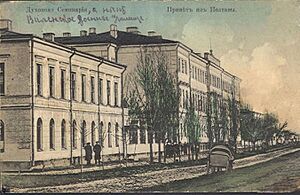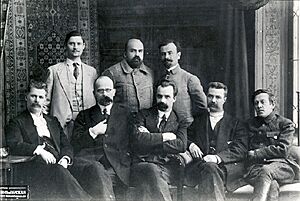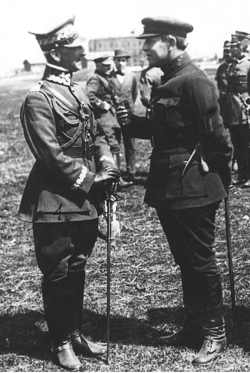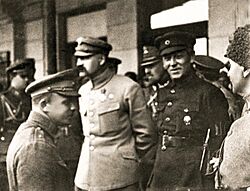Symon Petliura facts for kids
Quick facts for kids
Symon Petliura
|
|
|---|---|
|
Симон Петлюра
|
|
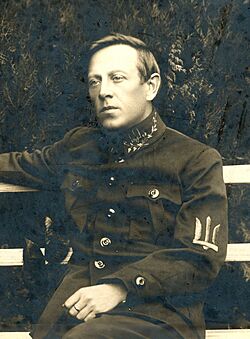
Petliura in 1919
|
|
| 2nd Chairman of the Directorate | |
| In office 11 February 1919 – 25 May 1926 (In exile from 18 March 1921) |
|
| Prime Minister |
|
| Preceded by | Volodymyr Vynnychenko |
| Succeeded by | Andriy Livytskyi1 |
| Secretary of Military Affairs | |
| In office 28 June 1917 – 6 January 1918 |
|
| Prime Minister | Volodymyr Vynnychenko |
| Preceded by | Position established |
| Succeeded by | Mykola Porsh |
| Personal details | |
| Born | 22 May 1879 Poltava, Russian Empire |
| Died | 25 May 1926 (aged 47) Paris, France |
| Political party | RUP (1900–1905) USDLP (1905–1919) |
| Spouse |
Olha Bilska
(m. 1910) |
| Children | Lesya (1911–1941) |
| Alma mater | Poltava Orthodox Seminary |
| Occupation | Politician and statesman |
| Signature |  |
| Military service | |
| Allegiance | Ukrainian People's Republic |
| Branch/service | Ukrainian People's Army |
| Years of service | 1914–1922 |
| Rank | Chief Otaman |
| Commands | Haidamaka Kish of Sloboda Ukraine |
| Battles/wars |
|
| 1As President of Ukraine in exile | |
Symon Petliura (born May 22, 1879 – died May 25, 1926) was a very important Ukrainian politician and journalist. He was the main leader of the Ukrainian People's Republic (UPR) during the Ukrainian War of Independence. This war was part of the bigger Russian Civil War.
Petliura was born in Poltava to a family with Cossack roots. From a young age, he believed in socialism and Ukrainian nationalism. He wrote a lot about these ideas as a journalist. After the 1917 February Revolution ended the Russian monarchy, the Ukrainian People's Republic was formed. Petliura became the head of its military.
Later, he led a revolt that brought the Republic back after a brief break. He became the leader of the UPR in early 1919. He then made an alliance with Józef Piłsudski of Poland to fight against the Bolsheviks. Even though Poland won the Polish–Soviet War, Ukraine remained under Soviet control. This forced Petliura to live in exile, first in Poland and then in Paris.
During the Civil War, there were terrible acts of violence against Jewish people. Petliura's role in these events has been a topic of much discussion. In 1926, he was killed in Paris by Sholem Schwarzbard, a Jewish anarchist whose family members had died in the violence.
Contents
Early Life and Work
Symon Petliura was born on May 22, 1879, in a suburb of Poltava. At that time, Poltava was part of the Russian Empire. His parents, Vasyl Pavlovych Petliura and Olha Oleksiyivna, came from a Cossack background. His father owned a transportation business.
Petliura first went to local church schools. He had planned to become an Orthodox priest.
Education and Activism
From 1895 to 1901, Petliura studied at the Russian Orthodox Seminary in Poltava. While there, he joined a secret group called Hromada in 1898. When his involvement was discovered in 1901, he was expelled from the seminary.
In 1900, Petliura joined the Revolutionary Ukrainian Party (RUP). In 1902, to avoid arrest, he moved to Yekaterinodar in the Kuban region. He worked there for two years as a schoolteacher and then as an archivist. In December 1903, he was arrested for setting up a RUP branch and for writing articles against the Russian Tsar.
After being released in March 1904, he moved to Kyiv and then to Lemberg (now Lviv) in Galicia. In Lviv, he used the name Sviatoslav Tagon. He worked as an editor for several journals and newspapers, including Literaturno-Naukovyi Vistnyk. He also wrote many articles for Ukrainian newspapers in Galicia.
Return to Ukraine and Moscow
After a general amnesty was declared in Russia in late 1905, Petliura returned to Kyiv. Soon after, he moved to Petersburg to publish a socialist-democratic magazine called Vil’na Ukrayina ("Free Ukraine"). When Russian censors closed this magazine in July 1905, he went back to Kyiv.
In Kyiv, he worked for the newspaper Rada ("The Council"). From 1907 to 1909, he edited the literary magazine Slovo (The Word) and co-edited Ukrayina ("Ukraine").
Because Russian authorities closed these publications, Petliura had to leave Kyiv again. In 1909, he moved to Moscow, where he worked as an accountant for a short time. In 1910, he married Olha Bilska. They had a daughter named Lesia in 1911. From 1912 to 1917, he was a co-editor of the important Russian-language journal Ukrayinskaya Zhizn (Ukrainian Life).
Journalism and Writings
Petliura was an editor for many journals and newspapers. He wrote over 15,000 articles, reviews, stories, and poems. He used about 120 different pen names. His extensive writing in both Russian and Ukrainian helped shape the ideas of the Ukrainian people before the 1917 Revolution. His many contacts across Ukraine were very helpful when the Revolution began.
Publications Before 1914
The Ukrainian language was banned in the Russian Empire by the Ems Ukaz in 1876. This meant Petliura had more freedom to publish Ukrainian articles in Saint Petersburg than in Ukraine. There, he published the magazine Vilna Ukrayina ("Independent Ukraine") until July 1905. However, the Tsar's censors closed this magazine, and Petliura moved back to Kyiv.
In Kyiv, Petliura first worked for Rada. In 1907, he became the editor of the literary magazine Slovo. He also co-edited the magazine Ukrayina.
In 1909, Russian imperial police closed these publications. Petliura moved back to Moscow to continue publishing. There, he was a co-editor of the Russian-language journal Ukrayinskaya Zhizn. This journal helped inform the local population about the news and culture of what was then called Malorossia. He was the main editor of this publication from 1912 to 1914.
Publications After Leaving Ukraine
In Paris, Petliura continued to fight for Ukrainian independence through his writing. In 1924, he became the editor and publisher of the weekly journal Tryzub (Trident). He wrote for this journal using various pen names, such as V. Marchenko and V. Salevsky.
Revolution in Ukraine
Rise to Power
In May 1917, Petliura attended the First All-Ukrainian Congress of Soldier Deputies in Kyiv. On May 18, he was chosen to lead the Ukrainian General Military Committee. This committee is seen as the start of the modern Ukrainian Ministry of Defense.
When the Central Council of Ukraine was formed on June 28, 1917, Petliura became the first Secretary (Minister) for Military Affairs.
Petliura disagreed with the policies of the chairman, Volodymyr Vynnychenko. He left the government and became the head of the Haydamaky Kish, a military group in Sloboda Ukraine (in Kharkiv). In early 1918, this group had to defend Kyiv during the Uprising at the Kyiv Arsenal Plant. They also tried to stop the Bolshevik Red Guard from taking the capital.
After the April 1918 Ukrainian coup d'état, the government of Pavlo Skoropadskyi arrested Petliura. He was held in prison for four months.
Leading the Directorate
Petliura took part in the Anti-Hetman Uprising in November 1918. He became a member of the Directorate of Ukraine as the Chief of Military Forces. After Kyiv fell in February 1919 and Vynnychenko left Ukraine, Petliura became the leader of the Directorate on February 11, 1919. As the head of the Army and State, he continued to fight against both Bolshevik and White forces in Ukraine for the next ten months.
Challenges in 1919
When fighting broke out between Ukraine and Soviet Russia in January 1919, Petliura became the main leader in the Directorate. During the winter of 1919, his army lost most of Ukraine, including Kyiv, to the Bolsheviks. By March 6, they moved to Podolia.
In the spring of 1919, he stopped a coup-d'etat led by Volodymyr Oskilko. Oskilko was against Petliura working with socialists. Throughout the year, Petliura continued to defend the new republic. He fought against attacks from the Bolsheviks, Anton Denikin's White Russians, and Romanian-Polish troops. By autumn 1919, most of Denikin's White Russian forces were defeated. However, the Bolsheviks had become the strongest force in Ukraine.
The Polish Alliance in 1920
On December 5, 1919, Petliura went to Poland. Poland had already recognized him as the leader of Ukraine's legal government. In April 1920, as head of the Ukrainian People's Republic, he signed an alliance in Warsaw with the Polish government. They agreed on a border along the River Zbruch. Ukraine also recognized Poland's right to Galicia. In return, Poland would provide military help to overthrow the Bolshevik government.
Polish forces, joined by Petliura's remaining troops, attacked Kyiv on May 7, 1920. This was a key moment in the 1919–21 Polish-Bolshevik war. After some early successes, the forces of Piłsudski and Petliura had to retreat to the Vistula River and the Polish capital, Warsaw. The Polish Army eventually defeated the Bolshevik Russians. However, the Red Army remained in parts of Ukraine. This meant Ukrainians could not fully secure their independence.
Petliura led the Ukrainian government-in-exile from Tarnów in Lesser Poland. When the Soviet government in Moscow asked Poland to hand over Petliura, the Poles helped him "disappear." They secretly moved him from Tarnów to Warsaw.
Life After the Revolution
Bolshevik Russia kept demanding that Petliura be given to them. Several Polish friends and colleagues, like Henryk Józewski, protected him. After the Soviet Union was formed on December 30, 1922, Petliura left Poland in late 1923. He went to Budapest, then Vienna, Geneva, and finally settled in Paris in early 1924. There, he started and edited the Ukrainian-language newspaper Tryzub.
Promoting Ukrainian Culture
As the leader of the Directorate, Petliura actively supported Ukrainian culture both in Ukraine and among Ukrainians living abroad.
Supporting Culture in Ukraine
Petliura started giving the title "People's Artist of Ukraine" to artists who had greatly helped Ukrainian culture. A similar award was continued later under the Soviet government. One person who received this award was the blind kobza player Ivan Kuchuhura-Kucherenko.
Promoting Ukrainian Culture Abroad
Petliura also understood the importance of getting international support for Ukrainian arts through cultural exchanges. He strongly supported cultural leaders like the choreographer Vasyl Avramenko, conductor Oleksander Koshetz, and bandurist Vasyl Yemetz. He helped them travel internationally to promote Ukrainian culture.
Koshetz created the Ukrainian Republic Capella and took it on tour in Europe and the Americas. One of the Capella's concerts inspired George Gershwin to write "Summertime." It was based on the Ukrainian lullaby "Oi Khodyt Son Kolo Vikon." All three musicians later moved to the United States.
Life in Exile
In Paris, Petliura led the activities of the Ukrainian National Republic government in exile. He started the weekly newspaper Tryzub. He continued to edit and write many articles under different pen names. These articles often focused on issues of national oppression in Ukraine. His writings were known for their literary style. The idea of national awareness was often very important in his work.
Petliura's articles had a big impact on shaping Ukrainian national identity in the early 20th century. He published articles and brochures using various pen names, including V. Marchenko, V. Salevsky, I. Rokytsky, and O. Riastr.
Controversy and Assassination
Petliura is a controversial figure because of the violence against Jewish people that happened during his time leading the Ukrainian National Republic. Historians estimate that between 50,000 and 200,000 Jewish people were killed in Ukraine during the Civil War. Many different groups were involved in this violence.
Records show that 493 attacks on Jewish people between 1918 and 1921 were carried out by soldiers of the Ukrainian People's Republic under Symon Petliura's command. Other attacks were done by independent Ukrainian groups, Denikin's army, the Red Army, and the Polish Army.
The new Ukrainian state promised Jewish people equal rights. However, after 1918, military groups became involved in violence against Jewish communities. During Petliura's time as Head of State (1919–20), these violent acts continued in Ukrainian territory.
Petliura's role in these events has been debated since his assassination in 1926 and the trial that followed. Some historians say Petliura tried to stop the violence. They point out that he made it a crime punishable by death to carry out such acts. Others argue that he did not do enough to stop the violence. They suggest he might have been afraid to punish officers and soldiers involved, fearing he would lose their support.
Assassination in Paris
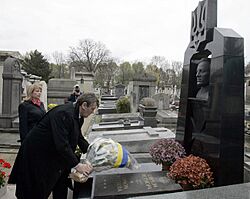
On May 25, 1926, at 2:12 PM, Petliura was walking on Rue Racine in Paris. A man named Sholom Schwartzbard approached him. Schwartzbard asked him in Ukrainian, "Are you Mr. Petliura?" Petliura did not answer but raised his walking cane. Schwartzbard pulled out a gun, shouted, "dirty dog, killer of my people, defend yourself!" and shot him five times.
Schwartzbard then surrendered to the police. He had a note that said: "I have killed Petliura to avenge the death of the thousands of pogrom victims in Ukraine who were massacred by Petliura's forces without his taking any steps to prevent these massacres."
Schwartzbard was an anarchist of Jewish background, born in Ukraine. His parents and fifteen other family members were killed in the violence in Odesa. In the trial that followed, Schwartzbard's defense argued that he was avenging the deaths of over 50,000 Jewish victims. The prosecution tried to show that Petliura was not responsible for the violence and that Schwartzbard was a Soviet agent. After an eight-day trial, the jury found Schwartzbard not guilty.
Some sources claim that Schwartzbard was a Soviet agent. They say he acted on orders from a former chairman of the Soviet Ukrainian government, Christian Rakovsky.
Petliura was buried next to his wife and daughter in the Cimetière du Montparnasse in Paris. His two sisters, who were Orthodox nuns and stayed in Poltava, were arrested and shot in 1928 by the NKVD (the Soviet secret police).
Legacy
In Ukraine
After the dissolution of the Soviet Union in 1991, many historical documents became available. This allowed politicians and historians to look at Petliura's role in Ukrainian history again. Some now see him as a national hero who fought for Ukraine's independence.
Several cities, including Kyiv and his birthplace Poltava, have built monuments to Petliura. A museum is also planned in Poltava. A statue of Petliura was put up in Vinnytsia in October 2017. To mark 80 years since his death, a twelve-volume collection of his writings has been published in Kyiv. Since 1992, annual readings called "Petliurivski chytannia" have taken place in Poltava and Kyiv.
In June 2009, Kyiv City Council renamed Comintern Street to Symon Petliura Street. This was to celebrate the 130th anniversary of his birth.
In modern Ukraine, Petliura is not as widely celebrated as Mykhailo Hrushevsky. This is because Petliura is closely linked to the violence of the time. In a 2008 poll of "Famous Ukrainians of all times," Petliura was not mentioned. In the 2008 TV show Velyki Ukraïntsi ("Greatest Ukrainians"), he placed 26th.
A nephew of Symon Petliura, Stepan Skrypnyk, became Patriarch Mstyslav of the Ukrainian Autocephalous Orthodox Church in 1990. In December 2022, the city of Izium renamed Maxim Gorky Street to Symon Petliura Street.
Among Ukrainians Abroad
For some Ukrainians living outside Ukraine, Petliura is remembered as a national hero. He is seen as a fighter for Ukrainian independence and a martyr. He inspired many people to fight for an independent Ukrainian state. He has been the subject of music and has inspired youth organizations.
Petliura in Ukrainian Folk Songs
During the revolution, Petliura became a popular subject in folk songs. He was often shown as a hero calling his people to unite against foreign rule. His name became a symbol of freedom. An ethnographer recorded 15 songs about him. In these songs, Petliura is shown as a soldier, similar to Robin Hood. He is shown making fun of Skoropadsky and the Bolshevik Red Guard.
News of Petliura's death in 1926 led to many revolts in eastern Ukraine. These revolts were harshly put down by the Soviet government. Blind kobzars Pavlo Hashchenko and Ivan Kuchuhura Kucherenko created a duma (an epic poem) in memory of Symon Petliura. This duma became popular among kobzars in left-bank Ukraine.
The Soviets also tried to show Petliura in a negative way through art. They created humorous songs where Petliura was a traveling beggar with no real territory. Plays and operas also showed Petliura negatively. They often said he betrayed Western Ukraine to Poland.
However, the Ukrainian people continue to portray Petliura in their folk songs in a positive way, similar to how they remember Taras Shevchenko and Bohdan Khmelnytsky. He is compared to the sun that suddenly stopped shining.
| Preceded by position created |
Secretary of Military Affairs June 1917 – January 1918 |
Succeeded by Mykola Porsh |
| Preceded by position created |
Chief of General Bulawa Chief Otaman Nov. 1918 – May 1926 |
Succeeded by Andriy Livytskyi |
Images for kids
See also
 In Spanish: Simon Petliura para niños
In Spanish: Simon Petliura para niños
- List of national leaders of Ukraine
- Ukrainian Civil War
- Anton Denikin


